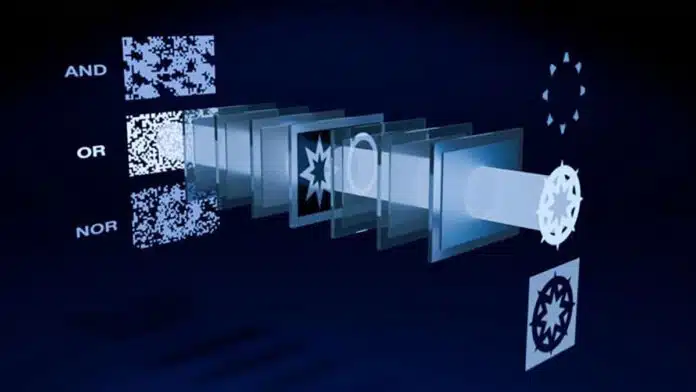
By Ashwini Sakharkar 3 Oct, 2024
Collected at: https://www.techexplorist.com/all-optical-system-converts-final-output-something-electronic-digital/90663/
The rapid advancement of technology has led to the development of increasingly complex applications such as artificial intelligence. However, this progress comes with a cost – the need for more powerful and power-hungry computers to run these applications. While electronic technology has been the foundation of all current computer devices, it is not without drawbacks, particularly in terms of heat generation and fabrication limitations.
In light of these challenges, optical computing has emerged as a promising alternative, offering the potential for increased speed and power efficiency. Despite its potential, optical computing has yet to be fully realized due to constraints and drawbacks. However, a new design architecture, known as diffraction casting, aims to overcome these limitations and revolutionize the field of optical computing.
The introduction of diffraction casting brings a fresh perspective to optical computing, offering the possibility of implementation in next-generation computing devices. By addressing the shortcomings of traditional electronic technology, this innovative approach not only promises improved performance and energy efficiency but also opens the door to new functionalities and features.
As researchers continue to explore alternative methods of computation, the potential of optical computing, particularly with the introduction of diffraction casting, presents an exciting opportunity to overcome existing limitations and usher in a new era of computing capabilities.
The future of computing may lie in a revolutionary idea that has been around for decades but has yet to fully take off—optical computing. By harnessing the speed of light waves and their ability to interact with optical materials without generating heat, optical computing offers the potential for massively parallel, high-speed, and power-efficient computing. Imagine a world where a broad range of light waves can pass through materials simultaneously without interfering with each other. This promises a future of computing that is not only faster but also more energy-efficient.
“In the 1980s, researchers in Japan explored an optical computing method called shadow casting, which could perform some simple logical operations. However, their implementation was based on relatively bulky geometric optical forms, perhaps analogous to the vacuum tubes used in early digital computers. They worked in principle, but they lacked flexibility and ease of integration to make something useful,” said Associate Professor Ryoichi Horisaki from the Information Photonics Lab at the University of Tokyo.
“We introduce an optical computing scheme called diffraction casting, which improves upon shadow casting. Shadow casting is based on light rays interacting with different geometries, whereas diffraction casting is based on properties of the light wave itself, which results in more spatially efficient, functionally flexible optical elements that are extensible in ways you’d expect and require for a universal computer. We ran numerical simulations which yielded very positive results, using small 16-by-16 pixel black-and-white images as inputs, smaller than icons on a smartphone screen.”
Horisaki and his team have proposed an all-optical system that is revolutionary in its approach. Imagine a system that operates entirely through optical means until the final output, which is then converted to electronic and digital format. Their concept involves using an image as the primary source of data, opening the door for applications in image processing as well as representation of other types of data used in machine learning systems.
They plan to combine the source image with a series of other images representing stages in logic operations. This can be visualized as layers in an image editing application, with the input layer as the source image and additional layers placed on top to obscure, manipulate, or transmit information from the layer beneath.
The output, or the top layer, will be processed by the combination of these layers. These layers will allow light to pass through them, casting an image (hence the “casting” in diffraction casting) on a sensor, which will then convert it into digital data for storage or presentation to the user. This innovative approach holds the potential to transform the way we process and visualize data.
“Diffraction casting is just one building block in a hypothetical computer based around this principle, and it might be best to think of it as an additional component rather than a full replacement of existing systems, akin to the way graphical processing units are specialized components for graphics, gaming, and machine learning workloads,” said lead author Ryosuke Mashiko.
“I anticipate it will take around ten years to become commercially available, as much work has to be done on the physical implementation, which, although grounded in real work, has yet to be constructed. At present, we can demonstrate the usefulness of diffraction casting in performing the 16 basic logic operations at the heart of much information processing, but there’s also scope for extending our system into another upcoming area of computing that goes beyond the traditional, and that’s in quantum computing. Time will tell.”
Journal reference:
- Ryosuke Mashiko, Makoto Naruse, Ryoichi Horisaki. Diffraction casting. Advanced Photonics, 2024; DOI: 10.1117/1.AP.6.5.056005

Leave a Reply